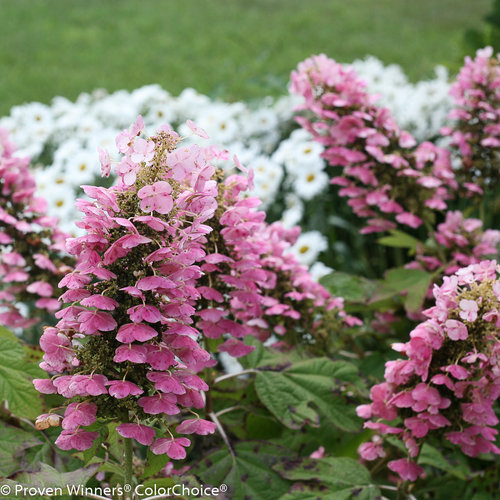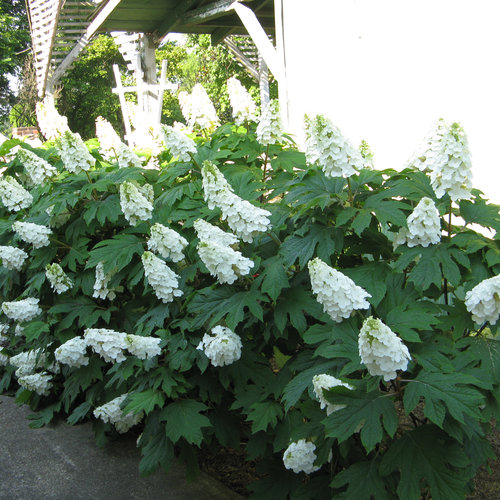Oakleaf Hydrangeas: The Queen Of The Shade
Oakleaf Hydrangeas: The Queen of the Shade
Oakleaf hydrangeas (Hydrangea quercifolia) are one of the most popular shade-loving shrubs in North America. They are known for their large, showy flowers, their beautiful fall foliage, and their relatively easy care.
Introduction
Oakleaf hydrangeas are native to eastern North America, where they grow in a variety of habitats, from forests to swamps. They are large shrubs, typically growing 4-6 feet tall and wide. Their leaves are large and resemble those of an oak tree, hence the name "oakleaf hydrangea."
The flowers of oakleaf hydrangeas are produced in large, conical clusters. The individual flowers are small and white, but they are surrounded by large, showy bracts that can be white, pink, or blue. The color of the bracts is affected by the pH of the soil. In acidic soil, the bracts will be blue. In alkaline soil, they will be pink.
Main Content
Oakleaf hydrangeas are a versatile plant that can be used in a variety of landscape settings. They are a good choice for shady borders, woodland gardens, and understory plantings. They can also be used as specimen plants or in mass plantings.
Oakleaf hydrangeas are relatively easy to care for. They prefer full to partial shade, but they can tolerate some sun. They are drought-tolerant once established, but they benefit from regular watering during the first two years after planting. Oakleaf hydrangeas prefer rich, well-drained soil.
Pruning
Oakleaf hydrangeas should be pruned in early spring, before the new growth begins. Pruning can be kept to a minimum by removing deadwood and crossing branches. If you want to encourage more flowers, you can prune back the previous year's growth by one-third.
Fertilizing
Oakleaf hydrangeas should be fertilized in early spring with a balanced fertilizer. A good option is a 10-10-10 fertilizer. You can also fertilize with a slow-release fertilizer in the fall.
Problems
Oakleaf hydrangeas are relatively problem-free plants. However, they can be susceptible to a few pests and diseases, including:
- Leaf spot: This is a fungal disease that causes brown spots on the leaves. It can be treated with a fungicide.
- Rust: This is another fungal disease that causes orange or yellow spots on the leaves. It can be treated with a fungicide.
- Scale: This is an insect pest that can suck the sap from the leaves. It can be controlled with insecticidal soap or neem oil.
Conclusion
Oakleaf hydrangeas are beautiful and versatile shrubs that are a joy to grow. With a little care, they will thrive in your garden for many years to come.
Oakleaf hydrangeas are beautiful shrubs that thrive in shade. If you're looking for a plant to add some color and interest to your shady spot, an oakleaf hydrangea is a great choice.
These shrubs can grow up to 6 feet tall and wide, and they produce large clusters of flowers in shades of white, pink, or blue. The flowers start out green and then gradually change color as they mature.
Oakleaf hydrangeas are relatively easy to care for. They need well-drained soil and regular watering. They also appreciate some fertilizer in the spring.
If you're interested in learning more about oakleaf hydrangeas, I recommend visiting . This website has a wealth of information about these beautiful shrubs, including planting tips, care instructions, and troubleshooting advice.
FAQ of oakleaf hydrangea shade
Q: How much shade does an oakleaf hydrangea need?
A: Oakleaf hydrangeas prefer partial shade, meaning they should receive 4-6 hours of direct sunlight per day. Too much sun can scorch their leaves, while too little sun will prevent them from blooming.
Q: What is the best soil for an oakleaf hydrangea?
A: Oakleaf hydrangeas prefer well-drained, acidic soil. The ideal pH range is 5.5-6.5. If your soil is alkaline, you can amend it with peat moss or sulfur.
Q: How do I water an oakleaf hydrangea?
A: Oakleaf hydrangeas need regular watering, especially during hot, dry weather. Water deeply once a week, or more often if the weather is very hot. Be sure to water the soil at the base of the plant, not the leaves.
Q: How do I fertilize an oakleaf hydrangea?
A: Oakleaf hydrangeas should be fertilized in early spring and again in late summer. Use a balanced fertilizer, such as 10-10-10, and follow the directions on the label.
Q: How do I prevent pests and diseases on an oakleaf hydrangea?
A: Oakleaf hydrangeas are relatively pest- and disease-resistant. However, they can be susceptible to aphids, scale, and powdery mildew. If you see any pests or diseases, treat them immediately with an appropriate insecticide or fungicide.
Image of oakleaf hydrangea shade
5 different images of "oakleaf hydrangea shade" from Pinterest:
This is a classic variety of oakleaf hydrangea, and it produces large, white blooms that can reach up to 12 inches in diameter. The blooms are typically tinged with pink in the spring, but they fade to a pure white as they age.


This variety is similar to the white oakleaf hydrangea, but it produces pink blooms. The blooms are typically a deep pink in the spring, but they fade to a lighter pink as they age.
This variety is known for its bright lime green blooms. The blooms are typically lime green in the spring, but they fade to a pale yellow as they age.
This variety is known for its long, cascading blooms. The blooms are typically white in the spring, but they fade to a light pink as they age.
This variety is a bit more rare, but it produces beautiful blue blooms. The blooms are typically blue in the spring, but they fade to a light lavender as they age.

Post a Comment for "Oakleaf Hydrangeas: The Queen Of The Shade"